| Pages:
1
2 |
Mateo_swe
National Hazard
   
Posts: 505
Registered: 24-8-2019
Location: Within EU
Member Is Offline
|
|
DIY Heating mantle
So i want to make my own DIY heating mantle.
I found inspiration on youtube, Nilamotk has a video that seem to produce nice heating mantles.
Here is video of his process of making the heating mantle:
https://www.youtube.com/watch?v=QKFC0ke_DOU&t=613s
He also have a DIY controller for the mantles here:
https://www.youtube.com/watch?v=QcayrE88mpI
Now i drawn a picture explaining the process with some additions of mine.
I attach it to this message with another pic of Nilamotks triac mantle controller.
I post this to get some input on the mantle design.
Nilamtok uses dry wall mix for his mantles but wouldnt it be better to use high temp concrete mix, the stuff they use for foundrys and ovens?
Maybe a mix of the hightemp concrete mix and plaster.
Another thing is the Kanthal-A1 heating coil. Maybe it could be put in ceramic beads?
The original design just put them in the plaster/dry wall mix.
Kanthal-A1 doesnt expand much at all when warm so the expansion isnt a problem.
Nilamotk drys the mantles, then bakes them in oven then finally start heating them with the Kanthal wire very slowly at low temps then at higher
temps.
He says they can explode or crack and fall apart if heated and mantle isnt completly dried.
Any one tried to make this kind of DIY heating mantles?
The triac heating circuit seem to be good and i would guess it works well.
It doesnt include any regulation or measurement of the temperature, just a potentiometer to control the heating.
It will be step 2 to incorporate temp measurement and PID regulation.
A stirrer function is also high on the improvement list.
Most mantles use a motor and a rotating magnet, that is a way to do it.
Maybe it can be done with coils like when spinning a brushless motor.
Well, first step is to make the basic version 1 of the mantle.
I be happy for any input regarding the construction, choice of materials and any improvement or pointing out potential weaknesses in the idea.
If the mantle is going to be used with very high temps i would think one might choose another design or choose hightemp materials.
But for temps up to 250-300°C i hope this will work.
I would like to thank Nilamotk for the original design.
What do you all think?
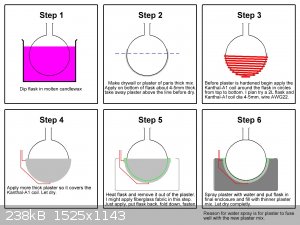 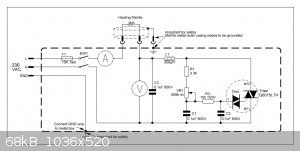
|
|
|
Ubya
International Hazard
    
Posts: 1232
Registered: 23-11-2017
Location: Rome-Italy
Member Is Offline
Mood: I'm a maddo scientisto!!!
|
|
before building my own heating mantle i also stumbled across his videos, the idea is ok-ish.
plaster of paris (gypsum) will lose strength if heated to high temperatures, so the layer next to the heating wire is going to crumble pretty fast.
the trimmer circuit, yeah sure you can build it or just buy a chinese trimmer module for less than the cost of the parts of that circuit (https://www.ebay.com/itm/AC-220V-5000W-SCR-Voltage-Regulator... this one has even a heatsink case).
i honestly just bought this heating mantle sleeve and added insulation around it https://www.ebay.com/itm/500ML-250W-Fiber-White-Adjustable-T...
---------------------------------------------------------------------
feel free to correct my grammar, or any mistakes i make
---------------------------------------------------------------------
|
|
|
Sulaiman
International Hazard
    
Posts: 3558
Registered: 8-2-2015
Location: 3rd rock from the sun
Member Is Offline
|
|
I did similarly to Ubya... a good choice
CAUTION : Hobby Chemist, not Professional or even Amateur
|
|
|
morganbw
National Hazard
   
Posts: 561
Registered: 23-11-2014
Member Is Offline
Mood: No Mood
|
|
I bought two heating mantle sleeves myself. They are cheap and make things a lot easier.
|
|
|
Mateo_swe
National Hazard
   
Posts: 505
Registered: 24-8-2019
Location: Within EU
Member Is Offline
|
|
So these ebay "sleeves" contain the heating element?
I must admit its a good idea instead of building the mantle from start.
Ill see if i can get one of those and start from there.
Thanks for the good idea.
|
|
|
morganbw
National Hazard
   
Posts: 561
Registered: 23-11-2014
Member Is Offline
Mood: No Mood
|
|
Quote: Originally posted by Mateo_swe  | So these ebay "sleeves" contain the heating element?
I must admit its a good idea instead of building the mantle from start.
Ill see if i can get one of those and start from there.
Thanks for the good idea. |
They do contain the heating element. You must be sure to buy according to the voltage that you intend to use. They do sell them according to a couple
of near global supply voltages. ((I bought mine for a 120 volt source)) some may need to buy one designed for a 220 volt source. Look for one that is
designed with your voltage requirement.
Too much voltage or too little voltage does not mean that they will not work but it is possible to send too much current through and burn it up or too
little voltage and not get the power/heat you were expecting.
|
|
|
Mateo_swe
National Hazard
   
Posts: 505
Registered: 24-8-2019
Location: Within EU
Member Is Offline
|
|
How do you all control the sleeve mantles?
Just using a variac or you use a triac circuit, PWM chopper?
Can i use a MYPIN TA4-SNR PID Temperature Controller (or similar) with a solid state relay and temp probe, building a nice mantle temp controller box.
|
|
|
G-Coupled
Hazard to Others
  
Posts: 287
Registered: 9-3-2017
Member Is Offline
Mood: Slightly triturated
|
|
You can get control boards cheaply on eBay and the like - links to the exact model(s) are around if you UTSE where people have discussed this. 
|
|
|
highpower48
Hazard to Self
 
Posts: 98
Registered: 30-10-2014
Member Is Offline
Mood: No Mood
|
|
I use a Variac to power mine...
|
|
|
earpain
Hazard to Others
  
Posts: 102
Registered: 11-9-2019
Member Is Offline
|
|
***Will fix image orientation soon, sorry about that***
The youtube video for the mantle building itself, lacks in that it seems to have been an afterthought. To make a video that is. So he does not
demonstrate in real time his process.
I decided to try out his method to the letter.
I suggest all to read the entire comment thread of the youtube video. The question of Gypsum's stability above 100C is brought up several times.
He refutes the concerns with mere empiricsm, by mentioning a later video where he uses these same mantles to distill Hg metal. There were comments
appearing as much as 1.5 years later where he insists none have broken.
Calcium Sulfate
| Quote: |
Molar mass: 136.14 g/mol
Formula: CaSO4
Melting point: 2,660°F (1,460°C)
|
He does agree with commentators that a refractive mortar or clay would be prefereble, but using Gypsum keeps the total budget of the project in the
'coulple of bucks' range.
I made a 50ml one controlling via 12VDC bench top power supply. It was about to boil water and then i melted the NiChrome.
I made a 500ml one, still trying to find a way to control it well.
Mine are super ugly , i had never cast gypsum before. But I must say, discovering the video early evening, and having a working model by ~12am,
thanks to a few broken blow dryers lying around, has been extremelly inspirational and educational.
Of course I probably will buy the proper equipment eventually.
Attachhed photos are of:
My two mantles that worked. 50ml and 500ml, plus some pictures of the ways I powered them. The first picture is a design for securing and insulating a
50ml RBF, complete with clamping arm. I exeriment with high temp silicone(RTV) at the bottom.
If this goes well, i'll post a new thread. Feeling very optimistic as I only stumbled upon aformentioned youtube video yesterday
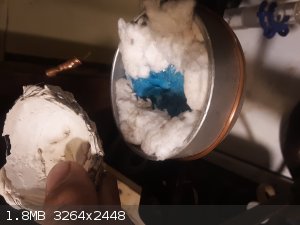
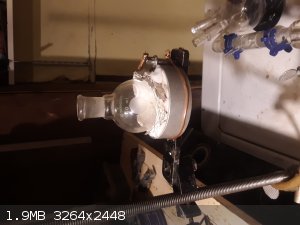 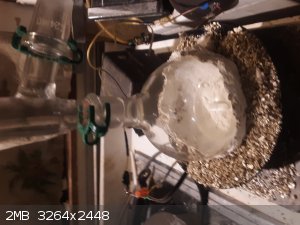 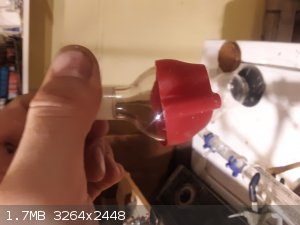
|
|
|
Mateo_swe
National Hazard
   
Posts: 505
Registered: 24-8-2019
Location: Within EU
Member Is Offline
|
|
I think you will get better at it and make more good looking ones with every mantle you make.
Its like this with every DIY idea, function and looks get better the more one is working with it.
I would choose Kanthal-A1 heating wire as it dont change resistance much at all with different temperatures.
It also doesnt expand so much when getting warm and this could be a problem when putting the wire in plaster/concrete.
You could put ceramic beads on the heating coil if your wire breaks.
But i wonder why your wire breaks, maybe you are running it too hot or use too little wire in your coil or too thin wire.
There are Kanthal/nicrome handbooks you can download for free with lots of info on these things.
Another way to do the heating element for heating mantles is to use these heating tape strips found on aliexpress.
They are really cheap 1.41 US$
Search Aliexpress for Glass Fiber Heating Tape 220V and you see them.
I think there is different lengths, power levels, voltages etc...
Or just buy one of those heating mantle sleeves on ebay as suggested above in this thread.
I think this seem to be one of the best ideas.
They are made for heating mantles and are little more expensive compared to making the heating element from Kanthal wire but are easily made into a
DIY heating mantle.
[Edited on 2020-5-19 by Mateo_swe]
|
|
|
earpain
Hazard to Others
  
Posts: 102
Registered: 11-9-2019
Member Is Offline
|
|
Quote: Originally posted by Mateo_swe  | I think you will get better at it and make more good looking ones with every mantle you make.
Its like this with every DIY idea, function and looks get better the more one is working with it.
I would choose Kanthal-A1 heating wire as it dont change resistance much at all with different temperatures.
It also doesnt expand so much when getting warm and this could be a problem when putting the wire in plaster/concrete.
You could put ceramic beads on the heating coil if your wire breaks.
But i wonder why your wire breaks, maybe you are running it too hot or use too little wire in your coil or too thin wire.
There are Kanthal/nicrome handbooks you can download for free with lots of info on these things.
Another way to do the heating element for heating mantles is to use these heating tape strips found on aliexpress.
They are really cheap 1.41 US$
Search Aliexpress for Glass Fiber Heating Tape 220V and you see them.
I think there is different lengths, power levels, voltages etc...
Or just buy one of those heating mantle sleeves on ebay as suggested above in this thread.
I think this seem to be one of the best ideas.
They are made for heating mantles and are little more expensive compared to making the heating element from Kanthal wire but are easily made into a
DIY heating mantle.
[Edited on 2020-5-19 by Mateo_swe] |
I quit smoking 5 years ago about, I became very acquianted with Kanthal. Actually only just now did I check out their website, directed at
wholesalers/engineers. Kanthal very often IS just that, Nickel + Chromium alloy. The vape shops have never known anything about the wire besides it
being 'Kanthal', or at least, I didn't know to ask.
In my case I know precisely why my wire melted: The hair dryer had a few gauges of Nichrome wound on it. I thought for the smaller 50ml mantle the
thinner gauge would be enough. I was carefully controlling and watching with my lab DC 0 - 20V Power Supply. It has needle gauges for voltage and
amperage. Anyway I was turning up the Voltage aiming for a faint orange glow, and one time turned it a bit too far. The part of the wire that melted
was the 1 in. or so that was suspended openly in the air.
Now I figured out to go Nichrome -> nickel with fiberglass insulation wrap -> copper, and make sure the heating coil has somethig to heat
besides itself.
Regardless I don't have the power yet to melt the thicker wire at all, unless i plug directly into the wall.
Yes I think getting some heating tape like in nerdrage's video or at least the bare minimum mantle sleeves would be much better. But i wanted to do
it right away lol.
Thanks for the detailed response. OP: Hope i'm helping your thread and not hijacking it=D
|
|
|
wg48temp9
National Hazard
   
Posts: 761
Registered: 30-12-2018
Location: not so United Kingdom
Member Is Offline
|
|
Quote: Originally posted by earpain  | ***
I suggest all to read the entire comment thread of the youtube video. The question of Gypsum's stability above 100C is brought up several times.
He refutes the concerns with mere empiricsm, by mentioning a later video where he uses these same mantles to distill Hg metal. There were comments
appearing as much as 1.5 years later where he insists none have broken.
Calcium Sulfate
| Quote: |
Molar mass: 136.14 g/mol
Formula: CaSO4
Melting point: 2,660°F (1,460°C)
|
|
That's the melting point of anhydrous sulphate. The set material is a dihydrate which converts back to the anhydrous material when heated the same way
all salts containing water of crystallisation do, cracking and crumpling in the process.
I would also expect the dihydrate to be electrically conductive to some extend which will probably corrode the heating wire due to the
electrolysis.
I am wg48 but not on my usual pc hence the temp handle.
Thank goodness for Fleming and the fungi.
Old codger' lives matters, wear a mask and help save them.
Be aware of demagoguery, keep your frontal lobes fully engaged.
I don't know who invented mRNA vaccines but they should get a fancy medal and I hope they made a shed load of money from it.
|
|
|
Mateo_swe
National Hazard
   
Posts: 505
Registered: 24-8-2019
Location: Within EU
Member Is Offline
|
|
I would guess plaster is not a good choice for making mantles.
But its quick and obviously works decently.
There are many other options if one starts to look into it.
The high temp bricks used when making a electric oven for melting or heat treating metals must be made of suitable materials.
When they make those cartridge heater elements they use a heating wire like kanthal/nicrome and put it in a metal tube with insulated inside surface
(oxide?) then fill with MgO.
So MgO seems it could be a material suitable, maybe mix it with hightemp concrete for foundrys and use that to cast a mantle.
When using plaster it seems very careful, and complete drying is important and then oven drying starting at low heat and after that start heat using
the Kanthal wire and very slowly go up in temps, like hours every step.
If moisture is left in the plaster and heating the mantle fast it will crack.
I can imagine it can be more of a poff!!! than a gentle crack.
Maybe not something one would want happen when heating something other than water.
But plaster works if one take the time to expel all moisture carefully.
I can imagine plaster degrading with usage.
I have ordered 3 of those mantle sleeves in different sizes.
They will be fun to try out and then build a controller box i can use for all 3 sizes, 500ml, 1000ml and 2L.
If it works well i start to think about adding stirring.
|
|
|
morganbw
National Hazard
   
Posts: 561
Registered: 23-11-2014
Member Is Offline
Mood: No Mood
|
|
You can buy high temp glass wool or rock wool fairly cheaply.
I would advise using one of these for the insulation.
|
|
|
Mateo_swe
National Hazard
   
Posts: 505
Registered: 24-8-2019
Location: Within EU
Member Is Offline
|
|
That is a good idea.
There are these ceramic blanket type of insulation that withstand very high temps but i dont think they are needed in a heating mantle application.
They are used as insulation for hi temp ovens.
Glass wool would be very good for a mantle, and cheap.
|
|
|
macckone
International Hazard
    
Posts: 2159
Registered: 1-3-2013
Location: Over a mile high
Member Is Offline
Mood: Electrical
|
|
My plan for a high temperature heating mantle is alumina ceramic beads and kanthal 20gauge wire.
I have ordered an appropriate 1000C 500ml quartz flask to go with it.
I have not quite figured out how to keep the beaded wire in place but 20 gauge is pretty stiff.
I will let you know how it turns out.
It takes 520cm of 20 gauge wire to equal about 1000W.
The ceramic beads are 10mm x 3mm.
Mineral wool insulation has a melting point of 2000F (1088C).
So a decent safety margin should allow 900C.
Higher than that and you need a tube furnace.
|
|
|
Mateo_swe
National Hazard
   
Posts: 505
Registered: 24-8-2019
Location: Within EU
Member Is Offline
|
|
I wonder if that quartz flask will hold up to 900°C.
I think for temps like 900°C you should have something like a crucible or alumina tube like in tube furnaces.
But maybe it does hold up, im no expert on high temperature devices or quartz glass.
Maybe you could use some of those high temp bricks, build a cube of these and then carve out a circular hole in the bricks.
Then your beaded heating wire could be laid out a spiral in the hole and secured in the bricks.
Please tell how it turns out, this is interesting stuff.
[Edited on 2020-7-7 by Mateo_swe]
|
|
|
macckone
International Hazard
    
Posts: 2159
Registered: 1-3-2013
Location: Over a mile high
Member Is Offline
Mood: Electrical
|
|
The flask is rated as 1000C working temperature.
They make another one with 1250C working temperature.
The difference is residual impurities in the glass.
The highest quality can have a working temp up to 1450C but that stuff is thousands of dollars.
|
|
|
Junk_Enginerd
Hazard to Others
  
Posts: 250
Registered: 26-5-2019
Location: Sweden
Member Is Offline
|
|
Gypsum plaster will take roughly 400°C without much problems. At a higher temperature it will lose most of its structural integrity, but not all of
it. If it's not exposed to stress and deformation, not much will happen, so I can imagine it'll do mostly okay in this application.
If reinforcement is added, it'll do much better. There's not a lot of options to choose from that aren't electrically conductive, but I think
fibreglass should help a lot. Soaking/coating the hardened plaster with a sodium silicate solution will help create a strong and refractory shell of
calcium silicate.
Adding about 50% by volume silica sand to the plaster "batter" as an aggregate is common practice for making more refractory plaster used for
investment casting. This should also help with heat conduction, as I think anything ought to be better than plaster.
|
|
|
Refinery
Hazard to Others
  
Posts: 371
Registered: 17-2-2014
Member Is Offline
Mood: Still
|
|
I personally would minimize the thermal mass of the mantle. Heating time rises, there will be hotspots due to uneven insulation, and when heating is
stopped, it takes forever to cool down.
Also using gypsum is no-go to me. Gypsum is in hydrated state when it is casted, and it evaporates a significant amount of water when heated. Gypsum
boards are fire resistant due to this reason because they absorb a lot of energy. When it dries, it cracks and crumbles. I attempted to make an oven
from gypsum and it was total failure. It took forever to heat up, most of that time was curing when water evaporated, and then it gradually crumbled
and burned my heating elements. The next oven I made was raku style, from ceramic wool. The body was from 10gal barrel and it weighted less than 5kg
with all parts, heated up in moments and the insulation was so good that you could move the oven around with gloves on.
I would try to find a piece of metal tube as a body and pot as a cap with proper sized hole in the middle for the flask, form a concave pit from wire
mesh (1/2" fence mesh for example) and wrap insulated heating tape in shape and then stitch a ceramic fabric on both sides to form a smooth bed with
no direct contact to heating elements. The fabric bed is then attached to the frame tube either with rivets, screws or something else that is rigid
and the lid is placed on top of it. Also a stirrer motor can be inserted in the bottom and enough ventilation to prevent it from overheating. Thermal
mass is minimized, the structure seems simple to me.
Most expensive part will be the insulated heating tape. 1000W element of longest type costs around 100 bucks according to Nurdrage, and it comes
plug-in-ready. Ceramic fabric is rather cheap, especially for a small application such as this. Not sure how well 1000W will heat up, but apparently
it should be enough up to 2L.
[Edited on 22-7-2020 by Refinery]
|
|
|
RogueRose
International Hazard
    
Posts: 1585
Registered: 16-6-2014
Member Is Offline
|
|
Just out of curiosity are you planning on adding a temp controller for these mantles? I recently made a clay crucible with nichrome inside it and it
worked fairly well except for the cracks that formed when I initially dried it b/c I cast it around a stainless bowl which couldn't be removed before
drying, so when I heated it, the metal expanded, cracking the clay, but was held together by the wire.
I used a router speed controller to control the temp and I have to say it worked very well. They are $15-20 at harbor freight but I think they sell
something similar on Ebay that is a bare bones "heater or motor controller" that is rated up to 2000 watts and they are available for $4-10 (more
expensive for domestically shipped). I suspect these would work well as a replacement as they seem very similar to a basic dimmer switch.
I'd really like to maybe start a project with others to make a temp controller that would ideally have a digital readout and a temp setting so the
unit keeps the temp where it needs to be. I think a standard K-type thermocouple would probably work and it might be ideal to have 2 inputs for
these, one for the heating surface and one for the reaction vessel. You could set a max temp for the element and a max or target temp for the
reaction and it would turn the element on/off as needed to keep the target temp. I think this could be pretty easily done with an arduino or maybe
even a custom PCB made for the project. If anyone is interested LMK as I have a few applications I'd like to use this for. I'm also working on a
similar setup but would also incorporate a pressure/vacuum sensor and control a pump as well. It would probably be easier to build one unit that has
the pressure sensor incorporated (they are inexpensive) than building 2 different models.
|
|
|
Fyndium
International Hazard
    
Posts: 1192
Registered: 12-7-2020
Location: Not in USA
Member Is Offline
|
|
I wonder if fire blanket fabric could be used as the mantle material of this type of heater? They are rated up to 900C with melting at 1100C.
Speed controllers rated to 2000W are available at ebay for 3 euros. I have used them for other projects and they have worked well. I believe you could
attach a digital display and calibrate it for temperature control.
|
|
|
RogueRose
International Hazard
    
Posts: 1585
Registered: 16-6-2014
Member Is Offline
|
|
Quote: Originally posted by Fyndium  | I wonder if fire blanket fabric could be used as the mantle material of this type of heater? They are rated up to 900C with melting at 1100C.
Speed controllers rated to 2000W are available at ebay for 3 euros. I have used them for other projects and they have worked well. I believe you could
attach a digital display and calibrate it for temperature control. |
I've wondered the same about the fire blanket but I don't think they transfer heat too well as most of them are made of either a fiber glass or a
ceramic of some kind and those work much better as insulations b/c of their refractory properties. I think that is why there are often small holes in
the mantles between the woven or knit cloth as it allows some heat to escape more easily. I do have to wonder how efficient these setups are compared
to using a direct contact like a hot plate or even a flame or hot air.
|
|
|
Refinery
Hazard to Others
  
Posts: 371
Registered: 17-2-2014
Member Is Offline
Mood: Still
|
|
Of course the concept is to enclose the flask inside the mantle so when heat is generated, it mostly stays in the mantle and is only absorbed through
the reaction flask. This is why the construction must involve an enclosure into which a hole is made just enough to lower a flask in. I would rather
want a low conductive material against a glass vessel to minimize hotspots. Placing a flask directly on heating element will cause huge thermal
gradients.
|
|
|
| Pages:
1
2 |